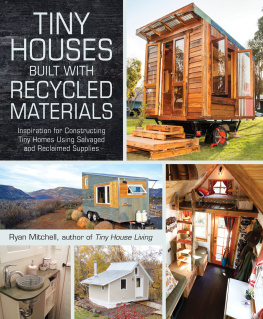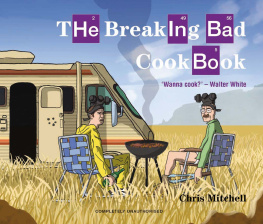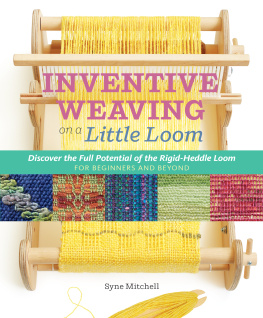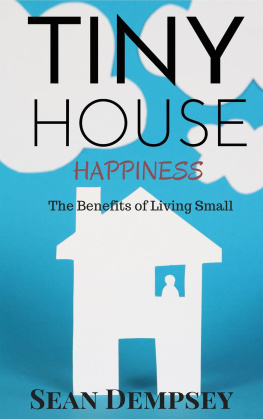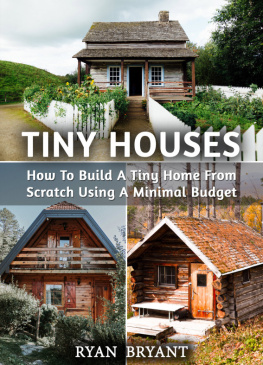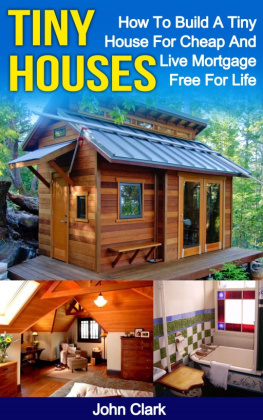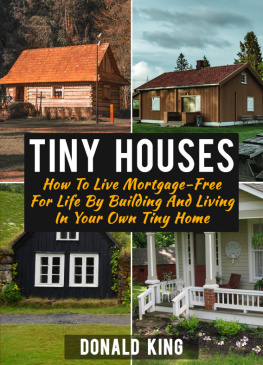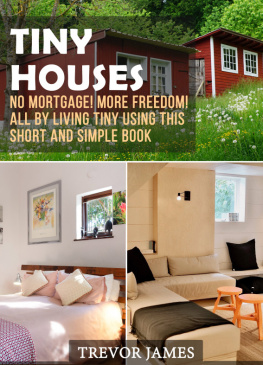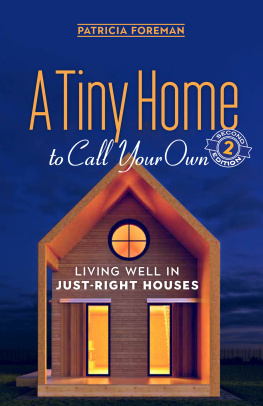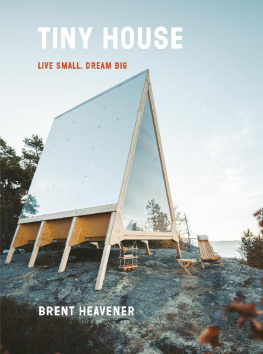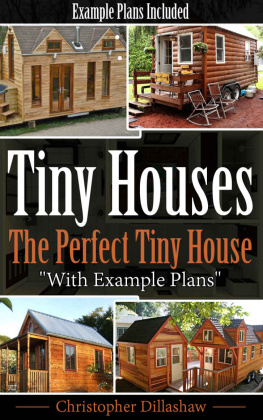Contents
Guide
TINY
HOUSES
BUILT WITH
RECYCLED
MATERIALS
Inspiration for Constructing
Tiny Homes Using Salvaged
and Reclaimed Supplies
Ryan Mitchell, author of Tiny House Living

Avon, Massachusetts
DEDICATION
To those who supported me in my dream to live tiny and beyond.
SPECIAL THANKS
A special thanks to Amy Annette Henion.
CONTENTS
PART I
RECLAIMING TINY HOUSES
1
WHY TINY? WHY RECLAIMED?
Tiny houses have captured the imagination of people for more than a decade now. The promise of affordable housing is an enticing proposition in todays world. We see people struggling to find themselves in this modern age, a time defined by bigger is better, keeping up with the Joneses, and a mentality that tells us we must always strive for more, go faster, and achieve perfection.
Tiny houses stand in stark contrast to this outlook. Small homes, which typically range from 100 to 400 square feet, have drawn much attention as a viable alternative to traditional housing because of cost, design sense, and environmental friendliness.
In this book we profile tiny houses of all shapes, sizes, and styles, which embody the spirit of the movement. These homes are built with a purpose: to pare down on space and possessions in order to focus on the important things in life.
While many want tiny houses to be confined in a neat box, the truth is a tiny house, at its core, is about breaking preconceived notions of what a house is.
The essence of a tiny home is not the square footage, it is not space-saving storage, it is not a particular style or design practice. Rather, a tiny house is a structure that provides everything you need to live your best life in the most efficient and cost-effective manner possible.
A tiny house is a home that conforms to the following three principles:
- It focuses on effective use of space.
- It relies on good design to meet the needs of the residents.
- It serves as a vehicle to a lifestyle that the resident wishes to pursue.
A tiny home for a family of four might be 1,000 square feet. For one single person a house of 150 square feet might be right, while another individual might want 300 square feet. All of these are tiny houses.
Reclaimed Materials and Their Role in Tiny Houses
There is often a correlation between people who are interested in tiny homes and people who are both environmentally conscious and budget minded. Their ethos are closely aligned. It is no surprise then that we find a lot of people using reclaimed materials in tiny houses.
Many looking to make the move into a tiny house are looking for a more affordable way to live. Others want to live in a home that is gentle on the earth and lessens their impact. Reclaimed materials are great in meeting both of these goals.
Lots of people dont have enough funds to build a home, so using reclaimed materials is the only way to make the construction of a house possible. They dont want to spend years saving, so using reclaimed materials can cut down on the time to when they can walk in the front door. Time and money are both precious commodities, and using reclaimed materials as a way to achieve your dream of living in a tiny home more quickly can have a profound impact on the trajectory of your life.
There are others who are drawn to the aesthetics of reclaimed materials, the rich tones aged wood can bring, the unique look of their house that comes from materials with a history. Often using salvaged materials can lead to innovations, creating homes with a lot of character. Many people like the fact that they are able to design and build a house that is purpose-built to their lives, their tastes, and their needs.
This is a strong contrast with modern-day tract homes, which are built on spec and optimized for an ideal buyer, a data-driven profile created by market research. That research is used to create a home that appeals to the largest segment of home buyers. What this means is todays modern homebuilding isnt really built for anyone; its built to maximize sale and resale. The person who lives in that home doesnt get a house built for her or his life but for someone elses.
Finally tiny house people love reclaimed materials because they allow for a story. The story comes both from the life that the materials afford them in a tiny house and the stories from the materials themselves. Obtaining reclaimed materials is a complex process. You must interact with many different people to piece together the materials for your house. Such a process, finding everything you need, often requires a strong social network of individuals. Through all our interviews with people who used reclaimed materials in their homes, we found they had to construct a strong web of relationships for their homes to be completed. This brings a narrative of connected humans and objects to each of these houses.
All these things add up to stories about the people who helped you build your tiny home and the materials that ended up in itstories that you then share with others when they come into the tiny house. In building your home, you are writing the next chapter in that materials story.
Tiny Home Cost
A huge advantage of tiny houses and, in particular, the ones that use reclaimed materials, is their cost. The expense of a tiny house pales in comparison to that of a traditional house. The cost of housing has grown dramatically over the past sixty-five years. This is particularly noticeable today when income has stagnated. In 1950 the median household income was $4,237 and the average house cost was $7,354 for an income to home cost equivalent of 1.7. Compared to today, the median household income is $51,939 and the average house cost is $343,300 for an income to home cost equivalent of 6.6.
This sharp increase means that most people can no longer afford to purchase a home. Even if they are able to earn enough to qualify for a mortgage, more and more homeowners owe more on their mortgage than they can actually earn in a standard working life. Mortgages used to have fifteen-year terms; today the norm is thirty years, but we are beginning to see a rise in forty-year mortgages and reverse mortgages just to make owning a home possible.
Considering the average home in America sold for $341,500 in 2015, tiny houses are a breath of fresh air. The average tiny home built by its owner costs an average of $20,000, a price easily achievable for many people with a few years savings. The houses we profile in this book range in cost from $7,000 to $25,000, the average being around $13,000.

Photograph by Aaron Maret
Tiny Home Design
Beyond the cost of the home, tiny houses are an attractive option because of their design. Often a great deal of care is devoted to their aesthetics and layout. They are homes that are built and designed from the ground up for the occupant, because to live in such a small space, you must have it perfectly customized to you.
Tiny home designers focus on both the structural and social aspects of a home. How does the design impact how its owner interacts with the space? How do the placement and design choices of storage, seating, windows, and materials impact the feeling of the space? Does the storage hide clutter to promote a clear mind? Do the windows extend the sight line to make the home feel bigger? Do the materials provide a warm sensory experience?

